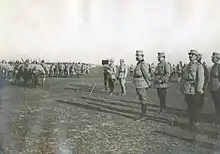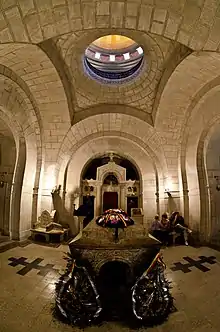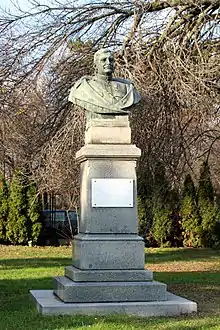Eremia Grigorescu
Eremia Teofil Grigorescu (28 November 1863 – 21 July 1919) was a Romanian artillery general during World War I, and Minister of War in the Constantin Coandă cabinet (October–November 1918).
Eremia Grigorescu | |
|---|---|
_-_image_from_page_456_of_%22Secrets_of_the_Balkans%22_(1921)_(14594155449).jpg.webp) | |
| Born | 28 November 1863 |
| Died | 21 July 1919 (aged 55) |
| Buried | |
| Allegiance | Romanian Army |
| Service/ | Artillery & Military engineering |
| Years of service | 1882–1919 |
| Rank | General |
| Commands held | 1st Army |
| Battles/wars | World War I–Romanian Campaign * Battle of Mărășești |
| Awards | Order of Michael the Brave, 2nd Class and 3rd Class Order of the Crown (Romania) |
| Minister of War | |
| In office 24 October 1918 – 28 November 1918 | |
| Prime Minister | Constantin Coandă |
| Preceded by | Constantin Hârjeu |
| Succeeded by | Artur Văitoianu |
| Minister of Industry and Commerce | |
| In office 24 October 1918 – 29 October 1918 | |
| Prime Minister | Constantin Coandă |
| Preceded by | Grigore G. Cantacuzino |
| Succeeded by | Alexandru Cottescu |
| Spouse(s) | Elena Arapu
(m. 1886; div. 1918) Elena Negropontes (m. 1918) |
| Children | Traian, Romulus, Aurelian, Lucreția, Margareta, Dan Ulise |
Early life
Born in 1863 in the village Golășei (Bujor Sat) near Târgu Bujor, in Covurlui County, now Galați county, he studied at the Vasile Alecsandri High School in Galați from 1870 to 1878, and then to the Costache Negruzzi National College in Iași from 1878 to 1881. He then attended for a year the Faculty of Medicine of the University of Iași, before transferring to the Military School for Infantry and Cavalry in Bucharest.[1] After graduating in 1884 with the rank of second lieutenant, Grigorescu pursued his studies in France, taking mathematics courses at the Sorbonne. He also attended special artillery and administration courses at the Military School of Saint-Cyr and at the French Ministry of War.
In 1903 he was appointed director of the Artillery section at the War Ministry, and from 1907 to 1910 commander of the Artillery Officer School.[1]
World War I

In 1917, during the Romanian Campaign of World War I, Grigorescu was the commander of the Romanian armies in the Battle of Mărășești. It was there that he achieved his greatest success, managing to defeat Imperial German troops led by General August von Mackensen. After the battle, Grigorescu was nicknamed the "hero of Mărășești". His victory was praised in Entente countries, and earned the general a sword sent to him by Yoshihito, the Emperor of Japan.[2] He was also a recipient of the Order of Michael the Brave (the highest military decoration of Romania), 3rd Class in October 1916, and 2nd Class in February 1918, as well as the French Legion of Honour, Grand Officer Class.

Grigorescu died in Bucharest in July 1919 of the Spanish flu. He was initially buried at the Mărășești military cemetery; his remains were later moved to the Mausoleum of Mărășești. The inscription on his sarcophagus reads: "With the guards at the Gates of Moldavia, who put a stop to the enemy standing as rocks next to me, I wrote in blood on the ridges of Slănic, Oituz, and Cașin: "You cannot pass through here.""[1]

Personal life
While studying in Iași in 1881, he met Elena Arapu, a Mathematics student who later became the first female graduate of the University of Iași, and pursued a teaching career. The two married on 15 November 1886, and had five children: Traian (1887–1969, who continued in his footsteps and became a general),[3] Romulus, Aurelian, Lucreția, and Margareta.[1][4] While stationed in Oituz during the war, he met Elena Negropontes, whom he married in 1918 after divorcing his first wife; their son, Dan Ulise Grigorescu (1917–1990), became a noted artist and photographer.[1]
Legacy
A district of Cluj-Napoca is named after him, and so was the village of Umbrărești-Deal between 1933 and 1950. There are also General Eremia Grigorescu streets in Brăila, Bucharest, Cluj-Napoca, Ploiești, and Timișoara. A bust of Grigorescu is displayed in Timișoara.
References
- Crângan, Costel (17 April 2018). "Povestea generalului român care a lansat celebra deviză "Pe aici nu se trece!". Victoriile lui au pus bazele Marii Uniri". Adevărul (in Romanian). Retrieved 9 August 2020.
- "Eremia Grigorescu's profile for the 100 Greatest Romanians campaign" (in Romanian). Romanian Television.
- "Traian Grigorescu". generals.dk. Retrieved 10 August 2020.
- Crângan, Costel (3 May 2018). "Cum a fost concediat de politicienii corupți un mare erou al României, după un scandal cât se poate de actual". Adevărul (in Romanian). Retrieved 9 August 2020.
External links
- Cupșa, Ion (1967). Mărăști, Mărășești, Oituz (in Romanian). Editura Militară. OCLC 12851232.
- Kirițescu, Constantin (1989). Istoria războiului pentru întregirea României 1916-1919. Vol. 1 (in Romanian). București: Ed. Științifică și Enciclopedică. OCLC 601609559.
- Ichim, Eugen (2000). Ordinul militar de război "Mihai Viteazul"l (in Romanian). București: Editura Jertfa & Modelism. ISBN 9738101018. OCLC 164578661.
- Nitu, Victor. "Battle of Mărășești (August-September 1917)". worldwar2.ro. Retrieved 10 August 2020.
| Wikimedia Commons has media related to Eremia Grigorescu. |
